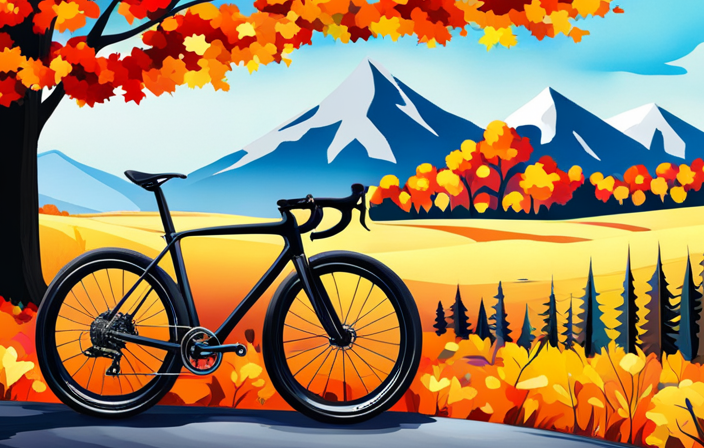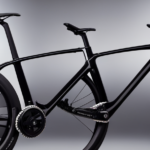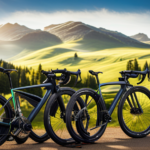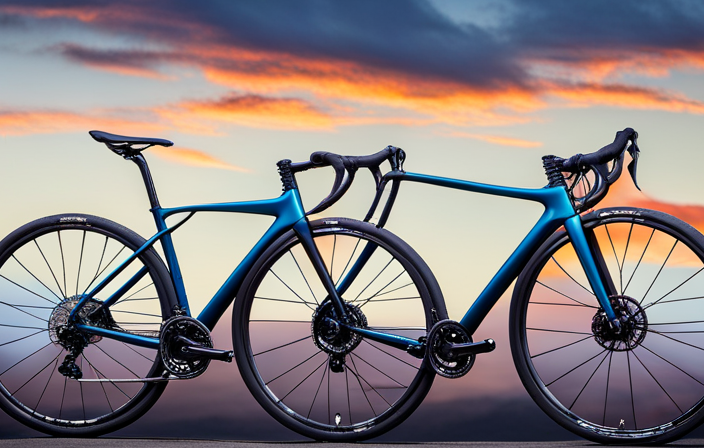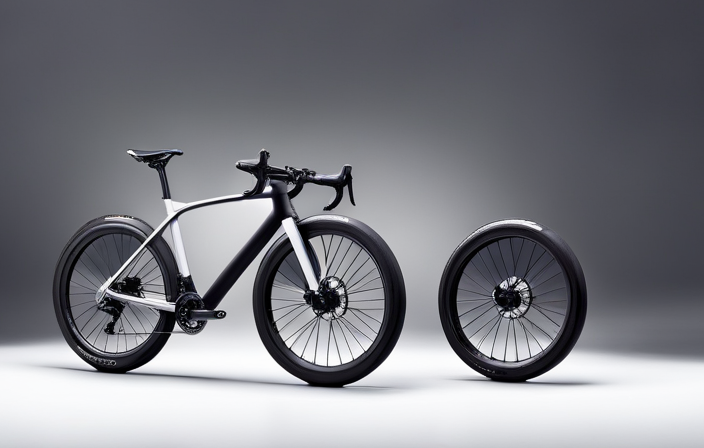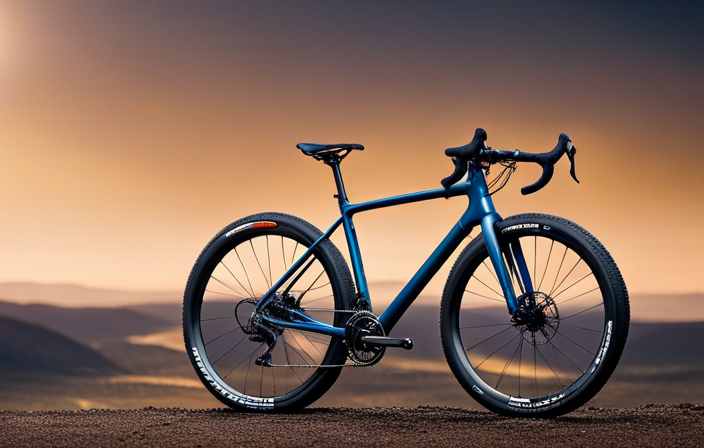People often compare a high-quality gravel bike to a reliable horse, prepared to guide you through grand journeys away from the common trails. Having dedicated numerous hours to navigating wild landscapes, I can confirm the significance of specific essential attributes in elevating a gravel bike to outstanding status.
From frame material and tire clearance to gearing options and saddle comfort, every aspect plays a crucial role in ensuring an enjoyable ride.
Join me as we delve into what makes a gravel bike stand out from the crowd.
Key Takeaways
- Frame material and design, such as steel, aluminum, or carbon fiber, play a crucial role in the performance and durability of a gravel bike.
- The geometry and wheelbase of the frame should be optimized for stability and control on different terrains.
- Disc brakes, whether mechanical or hydraulic, provide reliable stopping power, which is essential for gravel riding.
- Suspension or damping systems, along with accessories like bikepacking bags, add comfort and versatility to a gravel bike for long rides.
Frame Material and Design
The choice of frame material and design greatly impacts the performance of a gravel bike. When it comes to frame materials, there are three main options: steel, aluminum, and carbon fiber.
Steel frames are known for their durability and smooth ride quality, making them a popular choice among gravel riders.
Aluminum frames are lighter and stiffer, providing a more efficient power transfer but sacrificing some comfort.
Carbon fiber frames offer the best combination of lightness and stiffness, resulting in excellent performance on rough terrains.
In addition to the material, the design of the frame is also crucial. Gravel bikes typically have a longer wheelbase and slacker headtube angle compared to road bikes. This provides stability on uneven surfaces while maintaining control during descents.
The frame geometry also affects tire clearance and width. Gravel bikes usually have wider tire clearance than road bikes, allowing for larger tires that provide better traction and shock absorption on rough terrain.
When considering frame material and design for a gravel bike, it’s important to strike a balance between comfort, efficiency, and durability. A well-designed frame with appropriate tire clearance can enhance the overall riding experience on different types of gravel roads without compromising control or speed.
Moving onto tire clearance and width…
Tire Clearance and Width
When choosing a gravel bike, there are a few key factors to consider: tire clearance and width, tire tread, and geometry for comfort and stability.
Tire clearance and width are important because they directly impact the bike’s performance on different terrains. Tire clearance refers to the space between the frame and the tires, determining the maximum tire size that can be fitted. A good gravel bike should have generous tire clearance to accommodate wider tires, which provide better traction and stability on loose surfaces like gravel or dirt.
Tire width is another crucial factor to consider. Wider tires offer more surface area in contact with the ground, resulting in improved grip and better shock absorption. They also allow for lower tire pressure, enhancing comfort during long rides on rough terrain. The ideal tire width will depend on personal preference and the type of gravel riding you plan to do.
When it comes to tire tread, it’s important to choose one that suits your intended riding conditions. Aggressive tread patterns are suitable for muddy or loose surfaces, providing excellent grip but potentially sacrificing rolling efficiency on smoother roads. On the other hand, slick or semi-slick treads are more efficient on pavement but may lack traction on loose terrain.
In the next section, we will discuss the importance of geometry for comfort and stability.
Geometry for Comfort and Stability
To ensure a comfortable and stable ride, you’ll want to pay attention to the geometry of your gravel bike. The right combination of saddle height adjustment and handlebar reach adjustment can make all the difference in how well your bike fits and performs.
When it comes to saddle height adjustment, finding the right position is crucial for both comfort and efficiency. A saddle that is too high can lead to discomfort in the knees and hips, while a saddle that is too low can put strain on the quadriceps. Finding the perfect height will allow for optimal power transfer and reduce fatigue during long rides.
Handlebar reach adjustment refers to how far forward or backward your handlebars are positioned relative to your saddle. This adjustment directly affects your riding position and comfort. If the reach is too short, you may feel cramped or have limited control over your bike. On the other hand, if the reach is too long, you may experience discomfort in your neck, shoulders, or lower back.
By fine-tuning these two aspects of your gravel bike’s geometry, you can achieve a setup that maximizes both comfort and stability on any terrain. With a properly adjusted saddle height and handlebar reach, you’ll be able to ride longer distances with less fatigue while maintaining better control over your bike.
Now let’s move on to discuss another important aspect of a good gravel bike: disc brakes for reliable stopping power…
Disc Brakes for Reliable Stopping Power
For reliable stopping power on any terrain, you’ll want to consider disc brakes for your gravel bike. When it comes to disc brakes, there are two main types: mechanical and hydraulic.
Mechanical disc brakes are operated by a cable system, similar to traditional rim brakes. They offer good stopping power and are relatively easy to maintain. However, hydraulic disc brakes provide even greater reliability and control. With hydraulic fluid powering the braking system, they offer consistent performance in all weather conditions.
Another important factor to consider is brake pad compatibility with different wheel materials. Some brake pads may be better suited for alloy wheels, while others are designed specifically for carbon wheels. It’s crucial to choose the right brake pads that won’t compromise the integrity of your wheels.
Now let’s transition into discussing gearing options for versatility. When it comes to gravel riding, having a wide range of gears is essential for tackling various terrains and gradients without feeling too fatigued or underpowered.
Gearing Options for Versatility
Consider the different gearing options available to ensure versatility and optimal performance on a variety of terrains. When it comes to gravel biking, having the right gears can make all the difference in your riding experience.
One important factor to consider is shifting efficiency. You want a bike that allows for smooth and precise gear changes, especially when transitioning between climbs and descents. Look for a drivetrain system that offers quick and reliable shifting, so you can focus on enjoying the ride without any hiccups.
Gear ratio optimization is another key aspect to think about when choosing your gravel bike’s gearing options. Finding the right balance between low gears for climbing steep hills and high gears for powering through flat sections will greatly enhance your overall performance. A wider range of gear ratios gives you more flexibility in tackling various types of terrain.
Now, let’s transition into discussing suspension or damping systems. These components play a crucial role in providing comfort and control while riding off-road trails.
Suspension or Damping Systems
When it comes to gearing options for gravel bikes, we’ve explored the importance of versatility and how a wide range of gears can enhance your riding experience. Now, let’s dive into another crucial aspect that can greatly impact your ride quality: suspension or damping systems.
Suspension tuning plays a significant role in determining how well your gravel bike handles various terrains. Whether you’re tackling rough gravel roads or venturing off-road onto more technical trails, having the right suspension setup can make all the difference. It helps absorb bumps, reduce fatigue on long rides, and maintain traction on uneven surfaces.
When selecting a fork for your gravel bike, it’s essential to consider factors such as travel distance, adjustable features, and overall weight. A fork with adjustable settings allows you to fine-tune the amount of compression and rebound damping based on your preferences and the terrain you’ll be riding on.
The proper suspension system combined with optimal fork selection can greatly enhance comfort and control while riding your gravel bike. As we move forward in our discussion about what makes a good gravel bike, let’s now turn our attention to another critical component: handlebars and grips for control…
Handlebars and Grips for Control
To enhance control and stability while riding, it’s important to choose the right handlebars and grips for your gravel bike. Handlebar position plays a crucial role in determining your comfort and handling on rough terrains. When it comes to gravel biking, a wider handlebar with an ergonomic design can provide better control and leverage. This allows for more precise steering and maneuvering, especially when navigating through challenging obstacles like loose gravel or rocky trails.
In addition to handlebars, choosing the right grips is equally important. Grips that offer a good amount of cushioning can help reduce hand fatigue during long rides. Look for grips with ergonomic shapes that fit comfortably in your hands, providing optimal support and reducing pressure points.
Experimenting with different handlebar positions and grip styles can also help you find the perfect setup that suits your riding style and preferences. Some riders prefer a more upright position for better visibility on rough terrain, while others may opt for a slightly forward-leaning position to improve aerodynamics.
With the right choice of handlebars and grips, you’ll be able to enjoy greater control over your gravel bike while minimizing hand fatigue. And speaking of accessories, let’s explore the next section about mounting points without delay!
Mounting Points for Accessories
When it comes to gravel biking, having the right handlebars and grips is crucial for maintaining control and comfort on rough terrain. But there’s more to a good gravel bike than just that. Another important aspect to consider is the mounting points for accessories.
Having ample mounting options on your bike allows you to easily attach essential gear such as water bottle cages, racks, fenders, and bags. This is especially important when embarking on long rides or bikepacking adventures where you need to carry extra supplies. A well-designed gravel bike will have multiple attachment points strategically placed throughout the frame, fork, and seatpost.
These attachment points should be sturdy and reliable to withstand the demands of off-road riding. They should also be versatile enough to accommodate different types of accessories and mounting systems. Whether you prefer using traditional bolts or quick-release mechanisms, having options ensures that you can personalize your setup based on your specific needs.
Now that we’ve covered the importance of mounting points for accessories, let’s move on to another crucial aspect: weight and portability.
Weight and Portability
One important factor to consider when looking for a good gravel bike is the weight and portability. As an experienced rider, I know that having a lightweight bike can make a huge difference in your overall performance. A lighter bike is easier to handle and maneuver, especially on rough terrains. It allows you to ride with more agility and control, giving you the confidence to tackle any obstacles that come your way.
To achieve a lighter weight, manufacturers often use lightweight materials such as carbon fiber or high-quality aluminum alloys. These materials not only reduce the overall weight of the bike but also provide excellent strength and durability. Carbon fiber frames are known for their stiffness and responsiveness, while aluminum frames offer a good balance between weight and cost.
When it comes to portability tips, look for bikes that allow easy disassembly or folding mechanisms. This makes it convenient for transport or storage, whether you’re traveling by car or need to store it in a small apartment.
As we transition into discussing durability and strength in the next section, it’s important to note that finding the right balance between weight and durability is crucial in choosing a gravel bike that will stand up to tough off-road conditions without sacrificing performance.
Durability and Strength
The durability and strength of a gravel bike are essential factors to consider when choosing the right one for off-road conditions. As an experienced rider, I have learned that a durable and strong gravel bike can handle the toughest terrains and provide a reliable performance.
Here are five key aspects that contribute to the durability and strength of a gravel bike:
- Frame Material: Opting for materials like carbon fiber or aluminum ensures lightweight but robust construction.
- Weld Quality: Strong welds on the frame prevent cracks or failures during intense rides.
- Components: High-quality components, such as sturdy drivetrains and reliable brakes, enhance the overall strength of the bike.
- Durability Testing: Look for bikes that have undergone rigorous testing procedures to ensure they can withstand off-road abuse.
- Impact Resistance: Bikes with features like reinforced forks or shock-absorbing technologies protect against rough impacts.
When exploring wheel size and type in the next section, it is important to understand how these factors interact with the durability and strength of a gravel bike.
Wheel Size and Type
When it comes to gravel bikes, durability and strength are essential characteristics. However, another important aspect to consider is the wheel size and type. The right wheel setup can greatly enhance your riding experience on various terrains.
Gravel bikes usually offer different wheel size options, each with its own advantages. Smaller wheels, like 650b or 700c, provide nimble handling and better maneuverability on tight corners or technical trails. On the other hand, larger wheels offer improved stability and rolling efficiency over rough terrain.
In addition to wheel size, the choice between rim and tubeless tires is also crucial. Rim tires are more traditional and easier to find replacements for when needed. They also tend to be lighter and provide a smoother ride on paved roads. On the other hand, tubeless tires have become increasingly popular due to their ability to run at lower pressures without risking pinch flats or punctures.
To help you visualize the differences between these options, here’s a table highlighting their key features:
| Wheel Size | Handling | Stability | Efficiency |
|---|---|---|---|
| 650b | Nimble | Lower | Moderate |
| 700c | Moderate | Higher | High |
Now that we’ve covered wheel size and tire types in detail, let’s move on to another important aspect of gravel biking: pedals and cleat compatibility.
Pedals and Cleat Compatibility
Choosing the right pedals and cleat compatibility is crucial for an optimized riding experience on gravel terrain. When it comes to gravel biking, having the right pedal setup can make a significant difference in your performance and comfort. Here are four key considerations to keep in mind:
-
Cleat adjustment: Proper cleat positioning is essential for maximizing power transfer and reducing the risk of injury. Adjusting the cleats correctly ensures efficient pedaling motion and minimizes strain on your knees.
-
Pedal types: There are various pedal options available, including flat pedals, clipless pedals, and hybrid pedals. Flat pedals provide a large platform for better stability and allow you to easily dab your feet on technical sections. Clipless pedals offer improved efficiency by connecting your shoes directly to the pedal using a cleat system.
-
Float and release tension: Float refers to how much lateral movement your foot has when clipped into the pedal. It allows for natural foot rotation during the pedaling motion, reducing joint stress. Release tension determines how easy or difficult it is to disengage from the pedal, which is crucial when navigating challenging terrain.
-
Shoe compatibility: Different brands use different cleat systems, such as SPD or Look Keo. Ensure that your chosen shoe is compatible with your preferred pedal type before making a purchase.
Taking these factors into account will help you find the ideal pedal setup for gravel biking, enhancing both performance and comfort on rough terrains.
Next up, we’ll discuss saddle and seatpost comfort.
Saddle and Seatpost Comfort
To ensure a comfortable ride on rough terrain, you’ll want to consider the comfort of your saddle and seatpost. When it comes to gravel biking, finding the right saddle position is crucial. The position will not only affect your comfort but also your pedaling efficiency and overall performance. It’s important to find a saddle that supports your sit bones and provides enough padding for longer rides.
Additionally, seatpost adjustability plays a significant role in enhancing comfort on a gravel bike. Being able to fine-tune the height and angle of your seatpost allows you to customize the riding position based on your preferences and body geometry. A well-adjusted seatpost can help alleviate pressure points and reduce fatigue during long hours in the saddle.
When choosing a gravel bike, look for models that offer easy adjustments for both saddle position and seatpost height. This will allow you to dial in the perfect fit for maximum comfort on any terrain.
Transitioning into the next section about price and value for money, it’s important to note that while comfort is essential, it shouldn’t be the sole determining factor when purchasing a gravel bike.
Price and Value for Money
Price and value for money are important considerations when purchasing a gravel bike. As someone who has spent countless hours researching and testing different bikes, I understand the significance of finding a bike that not only fits my needs but also offers great bang for my buck.
Here are some discussion ideas to help you make an informed decision:
-
Brand reputation and customer support: Opting for well-known brands with a solid reputation ensures that you’re investing in quality craftsmanship, durability, and reliable customer support. It’s reassuring to know that if any issues arise, there is a reputable company standing behind their product.
-
Resale value and depreciation: While it may seem counterintuitive to think about selling your new bike before even buying it, considering its resale value can be beneficial in the long run. Some brands tend to hold their value better than others, which means you might recoup more of your investment if you decide to upgrade or sell later on.
Transitioning into the next section about test rides and reviews:
Now that we’ve talked about price and value, let’s delve into another crucial aspect of choosing a gravel bike – test rides and reviews.
Test Rides and Reviews
When looking for a new gravel bike, it’s important to try out different options and read reviews from other riders to ensure you find the right fit for your needs. Test rides allow you to get a feel for the bike’s handling, comfort, and overall performance on different terrain. It’s essential to spend some time riding the bike in various conditions to see how it performs in real-world scenarios. This will give you a better idea of whether the bike is suitable for your riding style and preferences.
In addition to test rides, reading expert reviews can provide valuable insights into the pros and cons of different gravel bikes. Experts have extensive knowledge and experience with various models, which allows them to evaluate each bike’s performance objectively. They often consider factors such as frame material, components, geometry, and overall design when assessing a bike’s quality.
By combining personal test ride experiences with expert reviews, you can make an informed decision about which gravel bike is best suited for you. Remember that everyone has different preferences and priorities when it comes to bikes, so what works well for one person may not necessarily be the perfect fit for another. Taking the time to gather information from both test rides and expert reviews will help ensure that you find a gravel bike that meets your specific needs and delivers an enjoyable riding experience.
Frequently Asked Questions
Are there any recommended maintenance tips for a gravel bike?
Gravel bike maintenance is crucial to keep your ride running smoothly. Some common gravel bike problems include frequent tire punctures, chain wear, and dirt buildup in the drivetrain.
To prevent these issues, I recommend regularly checking tire pressure and replacing worn-out tires and chains. Additionally, cleaning the drivetrain after every ride and lubricating it properly will help prolong its lifespan.
Regular maintenance like this will ensure your gravel bike stays in top shape for all your off-road adventures.
What types of terrain are gravel bikes best suited for?
When it comes to terrain, gravel bikes are the jack-of-all-trades. Unlike mountain bikes, they excel on a variety of surfaces, from smooth roads to rough gravel paths.
The key is in choosing the right tires for your gravel bike. Opting for wider tires with knobby treads provides better traction and stability on loose or uneven terrain.
This versatility allows me to confidently tackle any adventure, whether it’s a leisurely ride through the countryside or an off-road expedition.
Can a gravel bike be used for road cycling as well?
Yes, a gravel bike can definitely be used for road cycling as well. Gravel bikes have several advantages that make them versatile on different terrains.
They offer a more comfortable and upright riding position compared to road bikes, making long rides on paved roads more enjoyable.
Additionally, gravel bikes are equipped with wider tires that provide better stability and traction, allowing for confident handling on both pavement and gravel surfaces.
Overall, the performance of a gravel bike on the road is comparable to that of a traditional road bike.
How often should the tires be replaced on a gravel bike?
In my experience, tire longevity on a gravel bike depends on several factors.
For example, I had a friend who rode their gravel bike primarily on rough terrains and had to replace the tires every 6 months due to excessive wear.
Factors affecting tire wear include the type of terrain you ride on, tire pressure, and the quality of the tires themselves.
It’s important to regularly inspect your tires for signs of wear and replace them when necessary to ensure optimal performance and safety.
Are there any specific safety precautions to keep in mind when riding a gravel bike?
When riding a gravel bike, it’s important to take certain safety precautions.
Firstly, always wear a helmet and protective gear to protect yourself in case of accidents.
Additionally, make sure your bike is properly maintained by regularly checking the tire pressure, brakes, and chain.
It’s also crucial to ride at a safe speed and maintain control on loose surfaces.
By following these common maintenance tips and safety precautions, you can enjoy a safe and smooth gravel biking experience.
Conclusion
After carefully considering all the factors that make a good gravel bike, I can confidently say that it’s all about finding the perfect balance.
The frame material and design must be sturdy yet lightweight, while tire clearance and width provide stability on rough terrain.
Geometry ensures comfort and stability, while disc brakes offer reliable stopping power.
Gearing options allow for versatility in any situation. Pedals and cleat compatibility enhance control, while saddle and seatpost comfort are essential for long rides.
Finally, price and value for money should not be overlooked.
So, when it comes to choosing a gravel bike, remember to test ride and read reviews to find the one that suits you best!
